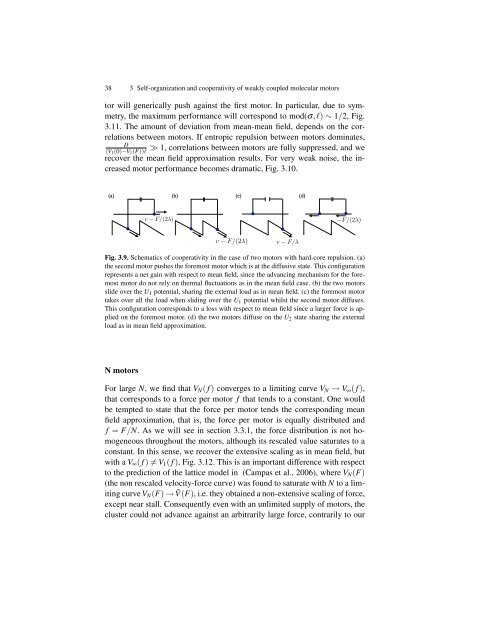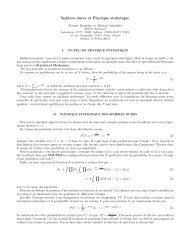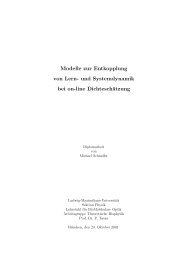Thesis (pdf) - Espci
Thesis (pdf) - Espci
Thesis (pdf) - Espci
Create successful ePaper yourself
Turn your PDF publications into a flip-book with our unique Google optimized e-Paper software.
38 3 Self-organization and cooperativity of weakly coupled molecular motors<br />
tor will generically push against the first motor. In particular, due to symmetry,<br />
the maximum performance will correspond to mod(σ,ℓ) ∼ 1/2, Fig.<br />
3.11. The amount of deviation from mean-mean field, depends on the correlations<br />
between motors. If entropic repulsion between motors dominates,<br />
D<br />
(V1(0)−V1(F))ℓ<br />
≫ 1, correlations between motors are fully suppressed, and we<br />
recover the mean field approximation results. For very weak noise, the increased<br />
motor performance becomes dramatic, Fig. 3.10.<br />
(a) (b) (c) (d)<br />
v − F/(2λ) −F/(2λ)<br />
v − F/(2λ)<br />
v − F/λ<br />
Fig. 3.9. Schematics of cooperativity in the case of two motors with hard-core repulsion. (a)<br />
the second motor pushes the foremost motor which is at the diffusive state. This configuration<br />
represents a net gain with respect to mean field, since the advancing mechanism for the foremost<br />
motor do not rely on thermal fluctuations as in the mean field case. (b) the two motors<br />
slide over the U1 potential, sharing the external load as in mean field. (c) the foremost motor<br />
takes over all the load when sliding over the U1 potential whilst the second motor diffuses.<br />
This configuration corresponds to a loss with respect to mean field since a larger force is applied<br />
on the foremost motor. (d) the two motors diffuse on the U2 state sharing the external<br />
load as in mean field approximation.<br />
N motors<br />
For large N, we find that VN( f ) converges to a limiting curve VN → V∞( f ),<br />
that corresponds to a force per motor f that tends to a constant. One would<br />
be tempted to state that the force per motor tends the corresponding mean<br />
field approximation, that is, the force per motor is equally distributed and<br />
f = F/N. As we will see in section 3.3.1, the force distribution is not homogeneous<br />
throughout the motors, although its rescaled value saturates to a<br />
constant. In this sense, we recover the extensive scaling as in mean field, but<br />
with a V∞( f ) = V1( f ), Fig. 3.12. This is an important difference with respect<br />
to the prediction of the lattice model in (Campas et al., 2006), where VN(F)<br />
(the non rescaled velocity-force curve) was found to saturate with N to a limiting<br />
curve VN(F) → ˜V (F), i.e. they obtained a non-extensive scaling of force,<br />
except near stall. Consequently even with an unlimited supply of motors, the<br />
cluster could not advance against an arbitrarily large force, contrarily to our




